 |
| Enrique Martínez, Chef-owner of one of
Navarra's top restaurants tastes a lineup of Chivite wines. |
Bodegas Julián Chivite is the undisputed leader among Navarra wineries taking a measured approach to winemaking. (www.chivite.com). Its family winemaking history — de padres a hijos desde 1647 — can be traced from fathers to sons and daughters (the late Mercedes Chivite was a key member of the family team) from 1647. The Chivites, once among Spain’s most elite wine families and in the same league with names such as Codorníu, Ferrer and Torres (Catalunya); López de Heredia, Marqués de Riscal and Muga and(La Rioja); and Gonzalez Byass and Hidalgo (Sherry), have been decimated by illness, death and a nasty family brouhaha. Led today by Fernando, the internationally recognized winemaker, now missing three of the siblings (tragically both Mercedes and Carlos Chivite both middle-aged died from cancer–Fernando himself is now in remission from the disease–and winery namesake Julián was recently purged from the winery in a sad family coup), Bodegas Julián Chivite’s fortunes are being closely observed by the Spanish wine world.
Ironically, the Chivite company is riding a wave of successful wine triumphs that includes international kudos that have earned it the reputation for making Navarra’s best wines, the successful expansion into La Rioja with the purchase and very successful quality upgrading of Viña Salceda, plans for making wine in the Ribera del Duero and the granting of the aforementioned D. O. status to the Señorío de Arinzano. There are literally no wines emanating from the Chivite bodegas in Centruénigo and Señorío de Arinzano (or the Viña Salceda winery in La Rioja Alavesa) that are not top drawer. Even Chivite ’s price-to-quality ratio Gran Feudo series excels with an unoaked Chardonnay, Spain's most popular garnacha rosado, a delicious tinto de crianza (tempranillo, garnacha, cabernet sauvignon), a reserva tinto (tempranillo, cabernet sauvignon and merlot), Viñas Viejas (a blend of tempranillo, garnacha, merlot and cabernet) and a moscatel dulce (sweet muscatel) — all benchmarks for affordable, consumer-friendly wines.
Chivite's stellar Colección 125 series — which commemorates the bodega’s 125th anniversary — includes a barrel fermented chardonnay that is consistently among Spain's top whites; a spectacular barrel fermented rosado made with six red varieties; a Bordeaux-esque tempranillo/cabernet sauvignon/merlot reserva; and a vendimia tardia (late harvest) Moscatel. Although some of these critically praised wines reach foreign markets, including the United States, much of
 |
| The renovation and re-design of the Chivite Arinzano estate was done
by architect Rafael Moneo, who built the Cathedral of Los Angeles (California). |
Colección 125 is snapped up by Spain's top restaurants. More elite is Chivite's Señorío de Arinzano Pago wines, which are made only in very good to great harvests. Several vintages are currently aging in bottle at the winery, the first three vintages -- 2000, 2001, 2002 -- of which were scheduled to be released this March. Just over 1,600 cases of each were made.
While Chivite reigns as undisputed royality in the Reyno de Navarra's wine kingdom, several other wineries form a very honorable color guard; they include Alzania, Nekeas and Señorío de Sarria, as well as the aforementioned Artazu, Guelbenzu, Magaña, Monjardín, Ochoa, Viña Aliaga and Ondarre. Of them, the Ochoa family (www.bodegasochoa.com) has been making wine in the fairytale castle village of Olite for 600 years. Javier Ochoa, the architect of the 1980’s modernization of the Navarra wine industry, currently heads the winery.
 |
| Castle Village of Olite |
Ochoa, whose grapes are all grown on 350 acres of estate vineyards, pioneered some of the first plantings of foreign varieties, such as cabernet sauvignon and merlot, here in the 1970s and 1980s. Ironically, he also revived interest in the ancient moscatel de grano menudo vines that grew in Navarra for centuries. Eschewing the traditional cloying, sometimes sherry-like style (the aforementioned Capricho de Goya is nevertheless a prime example and one of the greatest of Spain’s vinos generosos, at least that this writer has ever tasted), Ochoa began crafting fresh, lively vinos dulces de moscatel that he (and Chivite) refined into an art form, earning him kudos from top Spanish and international wine critics. Ochoa's bread-and-butter, however, is a line of vinos tintos — a competently made, but rather middling set of monovarietals, including a Tempranillo, a Cabernet Sauvignon and a Merlot, along with an expensive Vendimia Seleccionada 50 percent cabernet sauvignon/50 percent merlot blend that is aged for one year in Allier oak. Ochoa’s 2001 Reserva, another tempranillo/cabernet sauvignon/merlot blend, weighs in at 14% and is so tarry and licorice-like, it could be almost pass for a wine from Toro. Like most bodegas in Navarra, Ochoa also makes rosado; his 100 percent garnacha version (traditionally the best here) is a fine example of the category; a Rosado de Lágrima (made only from free-run juice) is a more novel 50/50 blend of garnacha and cabernet sauvignon.
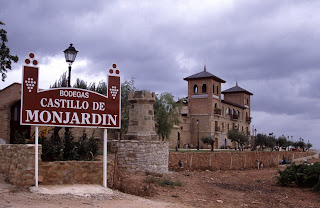 |
| Castillo de Monjardín winery |
Located in the Tierra de Estella subregion 30 miles northwest of Olite, along the Camino de Santiago in the pretty, castle-crowned village of Villamayor de Monjardín, is the showcase Castillo de Monjardín winery (www.monjardin.es). The bodega is housed in a striking, 19th-centuryesque, twin-towered, monastery-like building tastefully constructed of stone, old brick and wood with its own well-regarded restaurant that serves innovative, regional-inspired cuisine. Founded in 1988 by Victor del Villar and his wife, Sonia Olano, Castillo de Monjardin focuses on foreign varieties — chardonnay, merlot and cabernet sauvignon — planted on 370 acres of vineyards sited nearly 2,000 feet above sea level and periodically cooled by the strong, Mistral-like Cierzo winds that blow from the north. The line features a lovely, inexpensive, refreshingly unoaked El Cerezo Chardonnay; a barrel fermented chardonnay that is not over the top; and the unusual Esencia de Monjardín Reserva, a sweet late harvest chardonnay that spends four months in barrel. Monjardín's equally unusual and delicious rosado is 100 percent merlot, for which there is such demand that 15,000 cases are produced. The sound, well-made tintos include a cabernet-merlot reserva, a cabernet-tempranillo Reserva, a 100 percent cabernet sauvignon reserva and Deyo, 100 percent merlot.
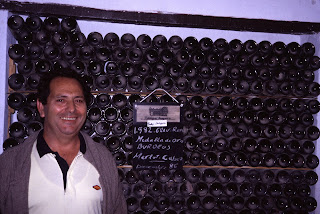 |
| Juan Magaña |
Since the 1970s, merlot has been a mainstay at Viña Magaña (www.bodegasyvinos.info/vinos/2054) in Barillas, a village a few miles outside the historic southern Navarra city of Tudela. The ever-restless owner, Juan Magaña, makes some of Spain's greatest merlots and merlot-cabernet blends from vines that were smuggled into Spain in the waning years of the Franco era. In fact, Magaña also ran his own nursery and supplied many of the top wineries in Spain with merlot and cabernet sauvignon vines during the 1970s and 1980s, when these foreign varieties become the rage.
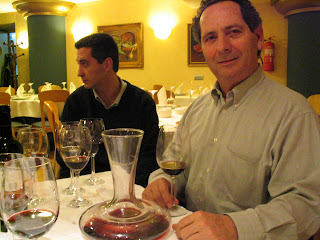 |
| Juan Magaña |
Magaña's noteworthy roster includes Dignus, a tempranillo-cabernet-merlot blend; Barón de Magaña, 70 percent merlot with the balance cabernet sauvignon and tempranillo; an excellent 100 percent Merlot; a merlot-laced reserva; a superb 70 percent merlot gran reserva that could pass for a top Saint-Émilion; and Calchetas, for which Magaña will not to divulge the grape makeup (an educated taste points to merlot, cabernet sauvignon and probably syrah and malbec), a big (14.5 percent), extracted wine that will satisfy the power palate aficionado.
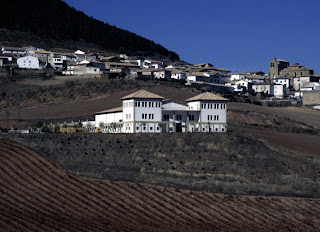 |
| Nekeas |
Technically a cooperative, but with a difference – its members are eight families from the same village with their own vineyards – at Nekeas (http://www.nekeas.com)/), longtime winemaker Concha Vecino makes a range of well-balanced, relatively inexpensive wines from native varieties (viura, tempranillo and garnacha), along with chardonnay, cabernet sauvignon and merlot. The finished wines include an inexpensive Nekeas Vega Sindoa Viura-Chardonnay, a crianza blend of Cabernet-Tempranillo, a Merlot crianza, a Cabernet-Merlot Reserva and the star of the line, El Chaparral de Vega Sindoa, made from 100 percent old vines garnacha aged six months in oak. This very successful winery is one of the stable nurtured by their U.S. importer Fine Estates From Spain’s Jorge Ordoñez, a Spaniard originally from Andalucia, who seems to be in perfect lock-step with the palate of American wine arbiter, Robert M. Parker, Jr., who, when he was still writing about Spanish wines rarely found an Ordoñez wine that he didn’t soon over. (Parker’s last Spanish review before he turned the beat over to Dr. Jay Miller covered the wines of Fine Estates From Spain exclusively--reportedly after heavy pressure from Ordoñez–which infuriated several other American importers of Spanish wines. I, personally, after living under the reign of the Bush cabal for the past seven-plus years, found nothing that comes out of the Washington, D.C. area, where the Robert M. Parker, Jr. Apellation Controleé/Denominación de Origen is headquartered (nearby Parkton, Maryland).
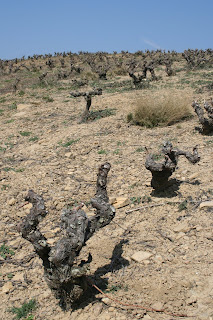 |
| Señorío de Sarría's superb Old Vines #5 Garnacha Vineyard in Navarra |
Old vines garnacha is the central theme at Artazu, located in the cooler Valdizarbe growing region near Puente de la Reina, whose arched medieval bridge is one of the major landmarks on the Camino de Santiago (http://www.europeancellars.com/Spain/Artazu). This relatively new project is headed by Juan Carlos López de la Calle of Rioja's Artadi, who makes a much sought after Artazuri garanacha rosado in stainless steel; a Garnacha tinto (from 60- to 80-year-old vines) that sees no oak; and a top-of-the-line Santa Cruz de Artazu Garnacha (from century-old vines) that is aged in large oak demi-muids (600-800 liters) for a year. Artazuri Rosado is one of best rosados I have ever tasted from Spain and is one of a rare genre of Navarra rosados that will live and improve in bottle for up to five and sometimes a long as ten years. Unfortunately, Sr. López de la Calle, chose to bottle the excellent 2006 with a plastic stopper and the 2007 with a screw-top, either of which will kill any plans that serious rosado lovers might have of putting this wine away for a couple of years. Having drunk Las Campanas Gran Reserva Garnacha Gran Reserva Rosados from 1961, which were spectacular still in the late 1970s, and having drunk this year and last several bottles of Señorío de Sarría’s rosados from their Viñedo #5 old vines Garnacha vineyards that were from 5-6 years old and still superb, I know from whence I speak. I can only hope that Sr. De la Calle decides to put future vintages under cork. Perhaps he will since several restaurateurs I talked to about it on trips to Spain in April and May were not planning to order the wine anymore because of the closures.
 |
| Señorío de Sarría’s Viñedo #5 old vines Garnacha vineyard |
For garnacha rosado fanciers, Señorío de Sarría's (www.bodegadesarria.com) superb Viñedo #5 Garnacha rosado, from a 50-year-old, high-altitude garnacha vineyard on its storybook estate near Puente de la Reina, is one of Spain's (and the world’s) greatest renditions of rosé wine. Sarría also produces a lineup of competently made wines from tempranillo, cabernet sauvignon, merlot and chardonnay along with a red called Viñedo Sotes (with the preceeding there red varietes plus native varieties mazuelo, graciano and garnacha) and good late harvest moscatel.
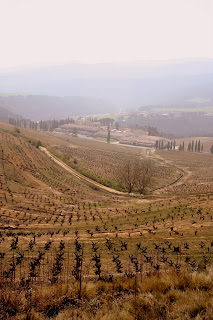 |
| Señorío de Sarría estate |
Drawing on fruit from vineyards located alongside Navarra's Bardenas Reales (a desert nature park), Azul y Garanza (http://www.azulygaranza.com/) makes its wines in a partially underground winery that still uses epoxy-lined concrete tanks–something a number of wineries are going back to using–dating to the period between 1940 and 1960. Its Rosa de Azul y Garanza garnacha-tempranillo rosado and a tinto blend of 80 percent tempranillo tinto, laced with 20 percent cabernet sauvignon have drawn favorable attention.
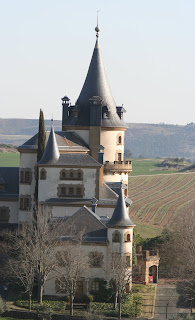 |
| Señorío de Sarría |
Viña Aliaga (Bodegas Camino del Villar; http://www.vinaaliaga.com/), a family-owned, vineyard-driven winery in southern Navarra makes an excellent garnacha rosado and moscatel dulce, along with several promising red wines made from garnacha, a superb ninety percent garnacha / ten percent cabernet sauvignon coupage called Antonio Corpus, several blends enlisting tempranillo and cabernet sauvignon and one of the finest Gracianos in the region. Aliaga, little known in the United States, has won a slew of prized in international competitions. Carlos Aliaga and his family have other business interests (toys, furniture), but seem dedicated to making serious wines with minimum of
 |
| Carlos Aliaga in his family's vineyards. |
intervention in the cellar.
Vinícola Navarra a.k.a. Las Campanas, beloved by Ernest Hemingway and generations of devotees of Pamplona's Fiestas de San Fermín, makes some delicious garnacha rosados (Las Campanas and the first-rate Castillo de Javier) and two serviceable tintos. It now belongs to the mega-group,
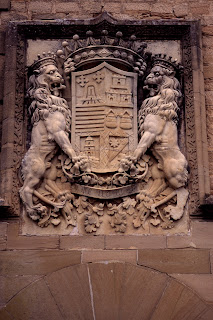 |
| Coat-of-arms at Palacio de la Vega winery |
Domecq Bodegas, which has acquired numerous Spanish wineries (including Palacio de la Vega, another Navarra producer) and bottles more wine than any entity in Spain.
Señorío de Otazu, the northernmost red wine vineyard–not just in Navarra, but they claim in all of Spain–lies in the moderate Valdizarbe subzone near the village of Echauri, just twelve kilometers from the gates of Pamplona. The Otazu estate is flanked by the Sierras del Perdón and Echauri and bordered by the Arga River, which flows down past the pens where the bulls are kept in Pamplona before the encierros of San Fermín each July and runs alongside about half of this spectacular 350-hectare estate property, where wines have been made
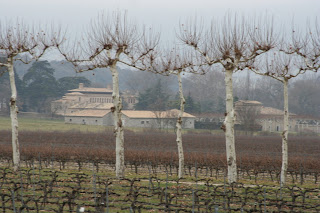 |
| Señorío de Otazu |
for centuries.
The 115 hectares of vineyards are planted in the noble varieties chardonnay, cabernet sauvignon, merlot and tempranillo. In corporated into the restored old bodega, Otazu features a very modern, artfully vaulted cellar (with a capacity of 200,000 liters) in the middle of an enchanting setting that includes the vineyards, a 12th-century stone torre (tower) integrated into a 16th-century palace, a 13th-century romanesque-gothic transition church and a 17th-century hermitage, all framed by carefully trimmed chopos (poplars) and some of the most important stands of oak trees left in Navarra.
Page 1 2 3
|